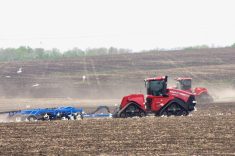Manitoba farmers are making significant seeding progress under good conditions, although moisture concerns are emerging.
Around eight per cent of intended acres were seeded as of May 6, ahead of last year’s four per cent and the five-year average of six per cent.
Dry weather favourable for field access
“Seeding progress across the province this past week has definitely…rapidly increased,” said Lionel Kaskiw, a crop production specialist with the province, at Manitoba Agriculture’s May 7 Crop Talk webinar.
After several good drying days, areas previously inaccessible are now easy to reach, Kaskiw added.
Most spring wheat seeding is about halfway complete in the central and Interlake regions with other areas catching up. Canola, sunflowers and pulse crops like field peas are also being seeded. Early-planted peas are already showing emergence.
Soil moisture levels a growing concern
Although dry conditions have allowed for efficient field work, they are raising red flags about soil moisture.
“Precipitation accumulations in most areas is far below normal for this time of year,” Kaskiw said.
There’s a lot more dust now too as producers work to get crops in the ground, he added.
The weather has been ideal for winter wheat and fall rye, which are utilizing moisture retained from the winter.
“The crop is jumping and starting to fill in in a lot of areas,” Kaskiw said.
Soybeans vulnerable to late frost
Soil conditions are now warm enough for early soybean planting, said provincial pulse specialist Dennis Lange. However, the warm weather could cause early emergence, making crops more vulnerable to a potential late May frost.
“That is something that would affect the soybeans and reduce stands in some instances,” Lange said.
Growers were generally reminded to weigh the benefits of early seeding against the ongoing risk of spring frost, which could persist into mid to late May in many regions.
Flea beetle activity increasing
Provincial entomologist John Gavloski cautioned growers to monitor for flea beetles in canola, especially as temperatures rise.
“That’s already started to happen, particularly with the striped flea beetles,” he said.
Crop protection key to managing ergot in fall rye
Anne Kirk, a cereals specialist, advised growers to rotate crops to reduce the risk of ergot in fall rye, which is particularly susceptible.
“You do want to make sure you have…at least a one-year break between susceptible crops,” she said.
















